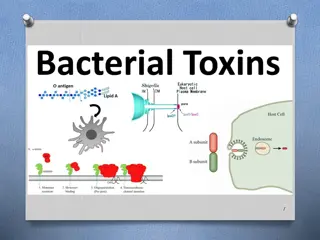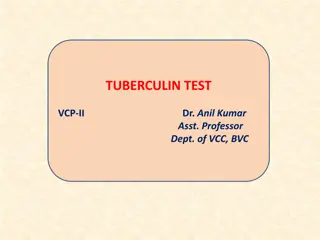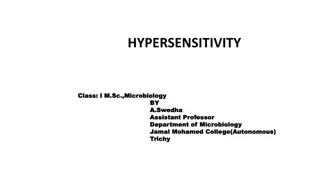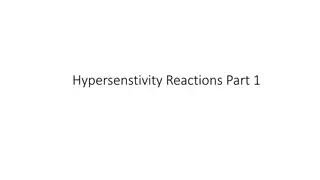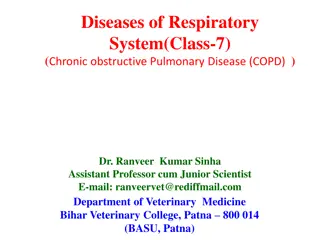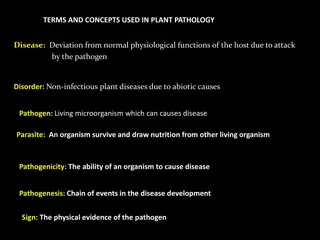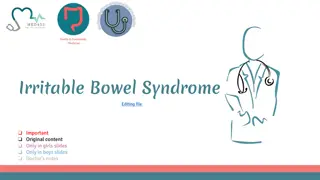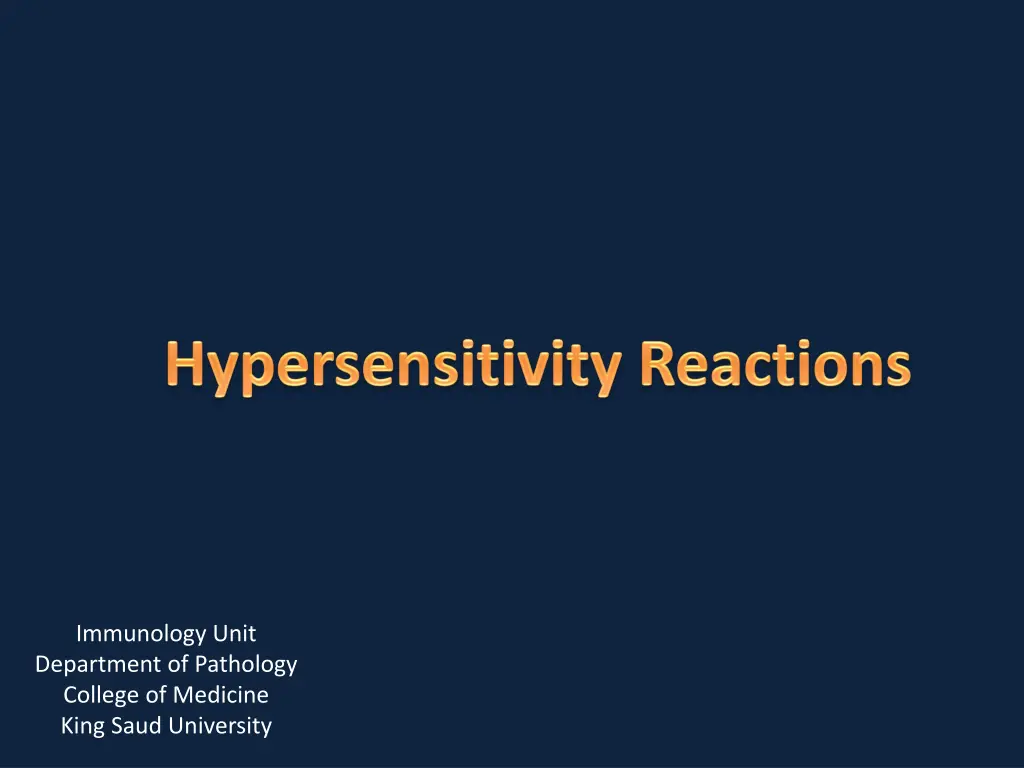
Understanding Hypersensitivity Reactions in Immunology
Explore the world of hypersensitivity reactions in immunology, from the overview of undesirable immune responses to the classification of different types like Type I, II, III, and IV. Discover the mechanisms behind allergic and autoimmune responses, as well as the role of antibodies and cell-mediated immunity in various hypersensitivity reactions.
Download Presentation

Please find below an Image/Link to download the presentation.
The content on the website is provided AS IS for your information and personal use only. It may not be sold, licensed, or shared on other websites without obtaining consent from the author. If you encounter any issues during the download, it is possible that the publisher has removed the file from their server.
You are allowed to download the files provided on this website for personal or commercial use, subject to the condition that they are used lawfully. All files are the property of their respective owners.
The content on the website is provided AS IS for your information and personal use only. It may not be sold, licensed, or shared on other websites without obtaining consent from the author.
E N D
Presentation Transcript
Immunology Unit Department of Pathology College of Medicine King Saud University
Reference Kuby Immunology 7th Edition 2013 Chapter 15 Pages 485-510
Objectives To know that hypersensitivity reactions are over and excessive immune responses that can be harmful to body in four different ways To be familiar with inflammatory processes in Type I hypersensitivity reaction that mediates allergic inflammation To recognize that Type II hypersensitivity deals with immune responses against antigens that are integral part of cell membrane and are usually associated with autoimmune disorders To know that Type III hypersensitivity reactions are mediated by immune complexes and cause vasculitis To describe Type IV hypersensitivity is a purely cell mediated immune response associated with chronic inflammation
What is hypersensitivity? Protective immunity: desirable reaction Hypersensitivity: undesirable reaction Undesirable responses can be mediated by Antibody binding to antigens (Types I-III) Cell mediated reaction to chemicals or proteins (Type IV)
Gel and Coombs Classification Type IV: Cell Mediated Immunity Type I: IgE Ab Type II: IgG Ab to tissue antigens Type III: IgG Immune Complexes
Type I: Immediate Hypersensitivity Most people will not react to these allergens but some individuals atopic respond by producing large amounts of IgE in response to those otherwise harmless substances Non-allergic individuals respond to these allergens by producing IgG antibodies
Type I Hypersensitivity Also termed as: Immediate Hypersensitivity Allergic reactions Anaphylactic reactions are severe and rapidly progressing systemic forms which can be quickly life threatening (Occurs within minutes to hours)
Features - Antibody type: IgE - Cellular components: Mast cells, basophiles & eosinophils - Antigens: Also known as allergens (antigens with low molecular weight & highly soluble)
Allergens Some of the allergens involved in type I hypersensitivity are: pollens, dust mite allergens, animal dander, nuts, shellfish, various drugs etc
Type I reactions occur in two phases Phase I : - Sensitization phase . - Sensitization phase . Allergen enter tissues , induce an immune response . B cells transform Phase I : - Sensitization phase First contact with allergens Type I Reaction occur in 2 phases: Allergen enter tissues , induce an immune response . B cells transform to plasma cells & produce IgE. to plasma cells & produce IgE. - IgE bind to receptors on Mast cells and basophiles ( F c RI - high affinity receptors). individuals become : individuals become : Subsequent contact with allergens - IgE bind to receptors on Mast cells and basophiles ( F c RI - high affinity receptors). - Challenge phase Sensitized . Sensitized .
Type I Hypersensitivity (Immediate) Sensitization Challenge
Primary and Secondary Mediators 12 June 10, 2025 Med 1
Allergy is a systemic disorder Nose Pharynx Allergic rhinitis Asthma Lungs Esophagus Food allergy Stomach Skin Eczema Urticaria Allergic dermatitis
Allergy: Rhinitis, Eczema & Conjunctivitis Normal nose
* Injected allergens: Hymenoptera (bees, wasps, ants) sting venom enters the blood stream Systemic inflammation Anaphylactic shock (life - threatening) Anaphylactoid reactions:- Are non - IgE mediated may result from contrast media or local anesthetics
Diagnosis of Allergy Skin Prick test 1. Skin prick test (SPT) 2. Specific IgE measurement (RAST) 3. Elimination / Provocation test (Food allergy)
Type II Hypersensitivity Reactions Features:- - IgG (or IgM) - Antigens: bound to cell membranes (Self antigens) - Exogenous antigens (microbial) - Complement activation (Invariable)
Clinical examples: Glomerulonephritis (anti-glomerular basement membrane) Mis-matched blood transfusion
Diagnosis - Detection of antibodies and antigens by Immunofluoresence in tissue biopsy specimens e.g. kidney, skin etc.
Type III: Immune complex hypersensitivity When an antigen reacts with an antibody the product they form is called an immune complex which is capable of inducing an inflammatory response Immune complexes are deposited in tissues like kidneys (nephritis), joints (arthritis) or blood vessels (vasculitis)
Type III Hypersensitivity (immune complex mediated) Features Antibody (IgG/ or IgM) + Antigen (soluble) - Immune Complex formation - Complement activation - Attraction of inflammatory cells
Type III Hypers. Reactions Clinical examples: Glomerulonephritis: Rheumatoid arthritis, SLE
Diagnosis of Type III Hypers. Reactions Demonstration of specific immune complexes in the blood or tissues by: Immunofluoresence
Type IV hypersensitivity reactions (Delayed Hypersensitivity) Features Cell mediated immune response Antigen dependent T cell (CD4 generally and CD8 occasionally) activation via MHC Class I or II Activated macrophages Delayed onset (2-4 days) Abnormal cellular response (Granuloma formation)
Development of DTH Response Sensitization phase: 1-2 week period Effector phase: 24-72 hours Effector cells (activated macs) act non-specifically
Type IV clinical examples: Contact dermatitis TB granuloma (persistent antigen)
Diagnosis (Type IV) 1. Delayed skin test (Mantoux test) 2. Patch test (Contact dermatitis) 3. Lymphocyte transformation test
Take Home Message 1. Type I (IgE), II (IgG) and III (IgG) hypersensitivity reactions are mediated by antibodies whereas Type IV hypersensitivity reaction is a cell mediated immune response. 2. Hypersensitivity reactions are undesirable, excessive, and aberrant immune responses associated with disorders such as allergy, autoimmunity and chronic inflammation.


